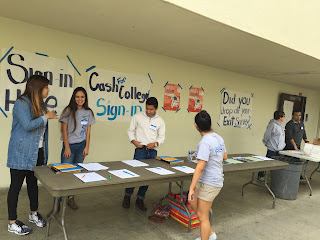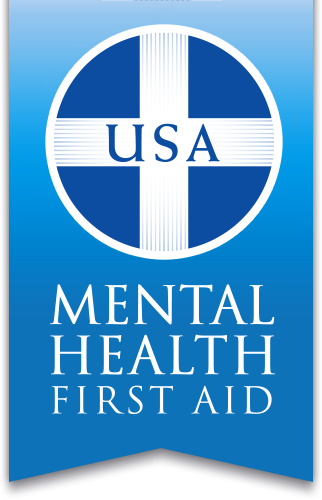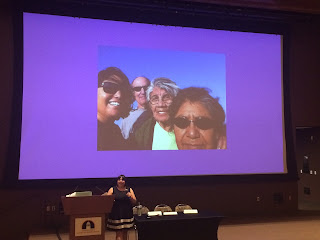Groundspark Blog Entry
Straight-laced Curriculum Training
Jennifer Bolaski - March 29, 2016
Professional Growth Opportunity Information: I attended the GroundSpark-Straightlaced Curriculum Training, presented by Nita Vjaters of San Diego Unified School District, on February 4th from 8:00am-3:00pm held at Monroe Clark Middle School in the Parent Center located in City Heights. I decided to attend this training because our practicum site currently has a Gay Straight Alliance (GSA) club during lunch.
Objective: The focus of this training was to help educators “create an inclusive, bias-free school and community by giving youth and adults the tools they need to openly discuss diversity in all its forms.” The director created this program to bring attention to how all youth are affected by homophobia and gender pressures. The film shares the stories of more than 50 students who share the pressures they are dealing with around culture, gender and sexuality. The curriculum is fairly new (2011) and does not mention any evidence based data.
Key Themes & Issues:
- Gender pressures and expectations are all around us, limiting youth from reaching their potential
- Gender expectations exist across cultures and are expressed differently in different contexts.
Audience: The curriculum we were given is designed to be primarily used within high schools, grades nine and above because of mature themes such as sexuality, suicide, violence and drug use, however parts can be shared with middle school students. The activities are meant to use in groups. Counselors can use the unit of study lesson or simply share and discuss the film with their students. (Both resources are available for borrowing!) Although the curriculum was created for use with students, you can also share it in a different context such as hosting a parent/guardian/community screening of the film to engage viewers in exploring these issues. Another way to build support is to invite principals, administrators and colleagues to watch the film.
Assessment: To measure it’s effectiveness, students will first be given a personal experiences survey/questionnaire of approximately 14 questions such as: “Do you act differently when you are with a group of girls than when you are with a group of guys?” Students can then respond: “yes”, “no”, “sometimes” and explain/give an example. The survey can be used as a reference tool for students to measure and discuss their level of individual growth. Also included in the curriculum as a School Climate Assessment and the School and Community Action Plan. Both involve students working together in teams to assess different aspects of their school climate relating to gender and sexuality by developing their own research questions, carrying out quantitative and qualitative surveys and sharing their findings and coming up with a plan for action.
Considerations: Before beginning a lesson or showing the video, it is important to devout enough time for discussion, both in preparing students for what they are about to see, and allowing time to help them process what they saw. As a group, come up with some shared agreements for discussion in order to create a space where everyone feels safe and respected. Since the film has mature themes, it is recommended to provide some background to families (perhaps in the form of a letter) about what the students will be doing and why.
Counseling Techniques: The particular counseling techniques I will be sharing relate to the following two student objectives as outlined in the curriculum:
- Understand how gender-role pressures affect all young people’s lives
- Explore connections among issues of gender, sexual orientation, race, culture, class and other aspects of identity.
The training recommends coming up with group norms (such as the ones listed below) before beginning a group discussion. Some of the ones listed below are similar to the ones used for group therapy as outlined in our textbook and also include counseling strategies used in both Narrative Based Therapy and Solution-Focused Therapy.
.
- Be an active and caring listener
- Assume best intentions
- Use “I” statements
- Disagree respectively
- Support each other in trying on new ideas
- Point out hurtful comments
- Ask if you aren’t sure how to say something respectfully
- Keep the discussion confidential
- Everyone has the right to pass or not answer
- Allow everyone the chance to speak
The training also included techniques to use when facilitating dialogue. They recommend using participatory strategies such as THINK-PAIR-SHARE (participants think of a response quietly, then pair up and share) so that everyone has a chance to develop and express their own ideas.
When conversations turn unfamiliar, model willingness to engage with new or unfamiliar topics or themes such as setting the tone, model thinking, and remind students of the right to pass.
Incorporation: Even though I plan on becoming an Elementary School Counselor (and may not use the film itself with my younger students) I plan on incorporating the techniques in the unit with my students such as developing lessons that include: developing empathy for others, learning skills to reach across differences and become an ally, and working toward creating safer and more inclusive climates. I also would start a social justice club. I may use the film during a staff meeting or parent night to create awareness of the issues. As an educator, the training also included 10 Things You Can Do to Make a Difference:
- Honor the identity of every student
- Reach out to those that are marginalized
- Ensure the visibility and acceptance of a wide range of gender experiences, identities and forms of expression.
- Set clear school rules and expectations that promote safety and respect.
- Engage in professional development on issues of gender, sexuality, bias and equity.
- Teach about gender, sexuality, culture, race and other diversity issues.
- Intervene when you witness bullying, bias, harassment or disrespect.
- Sponsor a gender support group, social justice club, or Gay-Straight Alliance
- Ensure school policies are fully inclusive of both girls and boys, as well as of gay, lesbian, bisexual, transgender, and gender nonconforming students, and students of all racial and ethnic backgrounds.
- Engage parents, guardians and caregivers in this dialogue.
Link to the video trailer: http://groundspark.org/our-films-and-campaigns/straightlaced

 There were several inspirations for me deciding to pursue a career as a school counselor. The main impetus was assisting my daughter with the college application process. In that process I also helped some of her friends that were also desperately seeking guidance on the tedious process of college applications. Now, having started down the path of receiving a Master in School School Counseling degree, the passion of wanting to help kids get to college has only grown stronger for me. In order to research this topic further, I attended a “Cash for College” workshop at Vista High School on January 31st to see how school counselors are assisting their students fulfill their college dreams with one of the most tedious parts of the college application process – financial aid forms.
There were several inspirations for me deciding to pursue a career as a school counselor. The main impetus was assisting my daughter with the college application process. In that process I also helped some of her friends that were also desperately seeking guidance on the tedious process of college applications. Now, having started down the path of receiving a Master in School School Counseling degree, the passion of wanting to help kids get to college has only grown stronger for me. In order to research this topic further, I attended a “Cash for College” workshop at Vista High School on January 31st to see how school counselors are assisting their students fulfill their college dreams with one of the most tedious parts of the college application process – financial aid forms. 


































